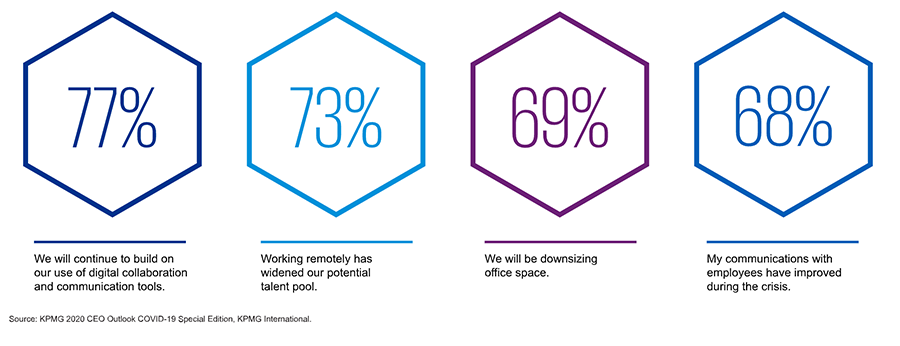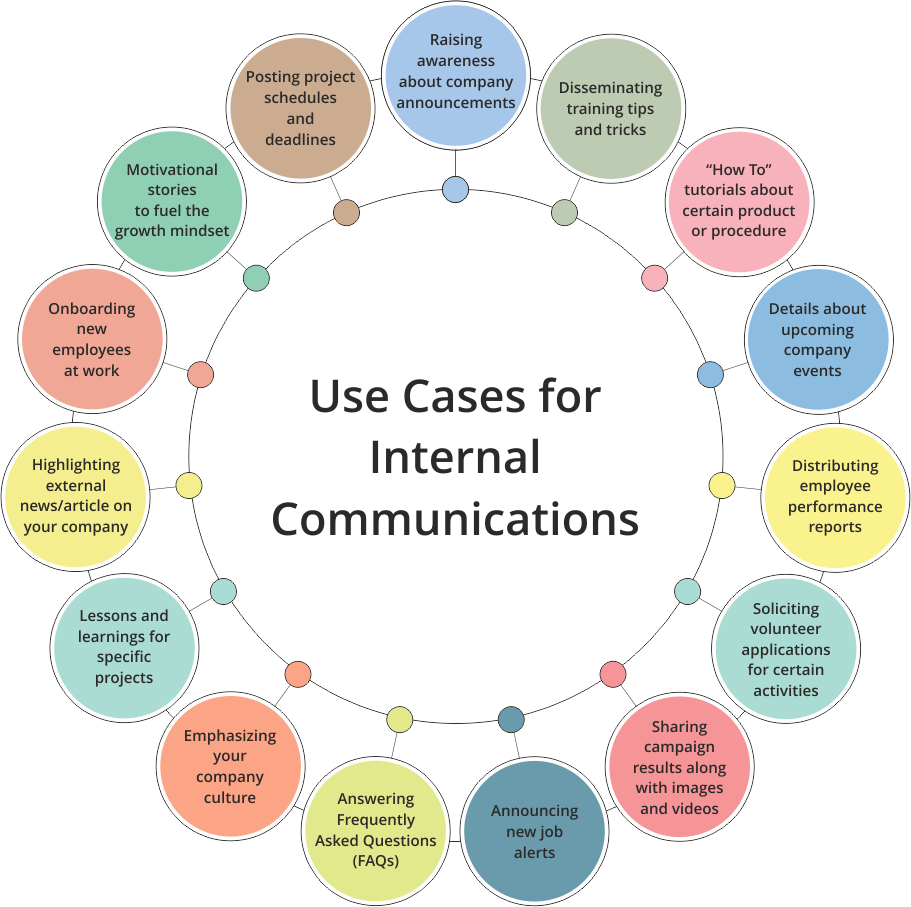Table of Contents
- Rise of internal communications
- What is internal communication?
- What are the types and channels of internal communication?
- Internal communication use cases
- Top 5 internal communication trends for 2023
- Reasons why internal communication is important in business?
- 7 simple steps to build an effective internal communications strategy
- How to spruce up your internal communication strategy
Step into a smarter digital workplace
Get a Free Product TourIn the aftermath of the events of 2020, remote working and workplace changes have become increasingly prevalent. Employers are now prioritizing employees’ well-being, providing them with learning opportunities, and sharing their values with their employees.
Throughout history, the workplace has been undergoing constant transformation, bringing along new challenges and ways of working. What’s new this year? How will 2023 differ from 2022?
Rethink the way you work and communicate

With these new dynamics scattering workforces and isolating employees, internal communications are now getting some well-deserved attention.
Dive into what internal communication means today. Get the trends, best practices, & strategies you need to drive excellent change in your organization.
At the start of the pandemic, it was business as usual. But soon, the companies started pivoting to new operating models to navigate the pandemic-induced roadblocks and challenges. This situation indicates the need to engage employees, create culture, share information, and instill a purpose within the organization.
The rise of internal communications
As remote working practices have caused workforces to disperse, the focus shifted to corporate messaging. Suddenly, all the employees started looking toward internal communication platforms for policy changes, real-time updates, corporate communications, messages from senior leadership during the moments of challenge.
With all eyes now on internal communications, the workforce needs to go the extra mile to ensure employee engagement. However, cracking the code for effective internal communication is no easy task, especially when the world of work is changing at an unprecedented rate.
On the bright side, the digital revolution is sweeping the role of international communication. But what exactly are the employee communication trends dominating organizations in the new normal.
What is internal communication?
Before we explore the trends and reasons why internal communication is successful, let us understand the concept first.
“Internal communication is the way a company interacts with its people, and they interact with it”.
At its core, internal communication refers to how people share information in the organization. The purpose is to provide an effective flow of information between the organization and the workforce. And this applies to both, top and down management. It is also concerned with the strategic view to ensure messaging has a purpose and impact. A solid international communications strategy helps in building employee engagement and nurtures company culture.
What are the types and channels of internal communication?
Workforce demographics are changing constantly, which highlights the need for diverse types and channels of communication. Wherever employees work, office or remotely, there is always a need for an internal communication strategy.
There is a multitude of internal communication: from peer-to-peer acknowledgment to top-down memos, from information campaigns to crisis communications, and more.
Every type of communication is designed to serve a different audience, a different purpose, and deliver a different outcome. While the organization may pay more attention to a specific type of communication, each has its value and is important to your internal communication strategy.
Types of internal communication
- Top-down communication
- Bottom-up or two-way communication
- Peer communication
- Team communication
- Culture communication
- Crisis communication
- Campaign communication
- Change communication
- Face-to-face briefing
Channels of internal communication
- Social media
- Discussion forums
- Intranet
- Face-to-face meetings
- Chat and private messaging apps
- Video calls
- Mobile
- Newsletter
- Internal blog
Internal communication use cases

Top 5 internal communication trends for 2023
1. The rising prominence of internal communications
Since we are living in a time of great and immediate change, the need to communicate quickly and effectively has become a real concern. Suddenly, outdated technology and systems have been highlighted for improvement and investment. Internal communications have taken the lead in educating the employees, communicating the relevant information in real-time, engaging employees, and much more. Leverage a full-fledged digital workplace solution to build an effective internal communication platform now.
2. Employee empowerment takes a front seat
Amidst heightened uncertainty, it is no surprise that workplace stress is increasing. Empowering employees with the right tools, resources, and technologies can lead to better engagement and participation. Over 73% of the American workforce feels burnt out of which 35% attribute it to the COVID-19 situation. This can lead to major disasters as burnt-out employees are more likely to become disengaged and cost up to 34% of their annual salary to their employers. Fortunately, the right corporate messaging approach can help manage stress levels at bay and empower employees to reach out for support. Start opening new internal communication channels to gain better employee sentiment insights.
3. The age of digital transformation
While digital transformation has been a priority for quite a long time, COVID-19 disruptions have fast-tracked this transformation process. However, employees need both, the desire and ability to use technology to thrive in this digital era. An internal communications platform holds the key to powering up digital transformation. As the world of work is changing rapidly, internal communication is required to align the workforce with the new vision and bring desired consumer experience into the workplace.
4. The need for real-time information
Time is the essence of the success of internal communication in business. Earlier, it was perfectly fine to send an email and wait for employees to read it over the week. Not anymore. Today, it is important to deliver messages instantly to ensure the internal communication best practices. The policies, key information, news, and updates with the team are now always in flux. When it comes to communicating change, any time lag could end up endangering work, health, and safety. Adopting agile communication approaches with a Microsoft 365 intranet can be extremely helpful to ensure real-time information across the organization.
5. Mobile-first communication
Business communications need to be accessible anywhere at any time. However, most organizations are still using the old-fashioned way of communication like emails, phone calls, face-to-face meetings. Today, mobile-first communication has become one of the biggest trends. An internal communication platform allows organizations to boost employee engagement, productivity, build collaboration, reduce misunderstandings, and more. However, the platform should offer mobile-first communication to ensure a direct communication channel and make it easier to find the latest resources and company news. And not to forget, millennials and Gen Z account for over a third of the workforce (38%) and the number will grow up to 58% within the next decade.
These younger generations are highly driven by mobile which is why this shift in internal communication methods has become a necessity.
Reasons why internal communication is important in business?
1. Employee engagement and culture amplification
Employee engagement is regarded as a critical activity because it directly impacts key areas like employee productivity, turnover, and even business profitability. And internal communication can play a significant role in harnessing the benefits of employee engagement . Let’s delve into some key aspects that require your focus:
- How do employees perceive the purpose and values of the organization?
- How do they feel about their leaders?
- How do they relate to the culture of the organization?
- How do employees feel about their future at your organization?
- How is the organization maintaining accountability and transparency with the employees?
- How do employees fit into the organizational strategy and perceive their role?
- What is their value in the organization?
Well, all these aspects can be taken care of by implementing an effective internal communication platform. If you do not have a professional approach to manage internal communications, BizPortals 365 can help you to leverage the opportunity to boost employee engagement. It also helps in celebrating and amplifying the organizational culture that can engage more employees.
2. Keeps every employee in the loop
Creating, dispersing, and managing communication is the foremost requirement of every organization. This is where internal communication plays an essential role. It keeps every employee informed of company information. This can help them with the right strategic and operational knowledge to manage their work accordingly. When the employees are fully aware and kept in the loop, they can easily put their work into perspective and carry out their roles effectively. While the organization distributes a huge amount of information to employees, you need an effective internal communication plan to grab the relevant information and reduce the noise.
3. Crisis communication
COVID-19 has shown the need for clear crisis communications that can be trusted by employees. The role of internal communication is not only to ensure crystal clear and consistent messaging but also, it must be effectively managed without leaving any room for misunderstandings. During COVID-19, the messaging clarity and good communications have supported the well-being of employees. It has also helped in minimizing the risks to business continuity in grim times. An employee communication software plays a vital role in improving internal communications during the crisis, and beyond.
4. Supports change with strong messaging
Another benefit of internal communication in business is that it helps in change management. It can be anything from following a new company policy, introducing new ways of working, modern technology practices, mergers, and acquisitions, and alike. Changes and transformation are prevalent and taking a professional internal communication strategy is essential to bring employees along on the change journey.
5. Targeting messages to diverse, global workforces
Workforces are diverse, with different languages, roles, locations, departments, regions, and divisions. The digital workplaces and related technologies offer the opportunity to target communication items to diverse groups and making digital communications relevant for everyone in the organization. Here, internal communication plays a vital role to ensure proper content targeting for diverse groups and resonates with all the employees.
6. Omnichannel approach
These days, there is a plethora of tools and software within the digital workplaces. Email, social media channels, intranet, chat apps, and public-facing sites have the potential role to play in a truly omnichannel environment. However, it takes the right skills and experience to manage communications across different channels and make the best impact depending upon the audience and message. Here, an effective internal communication strategy is necessary to make the best use of omnichannel and ensure a positive messaging impact.
7. Advising on best practices
The internal communicators also act as internal experts and consultants, helping to advise on best business practices and provide guidance to leaders. Not everyone in the organization is a trained communicator – senior leaders need support from professionals to get their messages across the organization, create and execute campaigns. Considering the importance of communications in various aspects of the organization, it is essential to have an internal communication platform to ensure best practices and provide professional support and guidance.
8. Managing the volume of messaging
A right internal communication approach leads to a more coordinated and centralized view of communication flows. It drives value in managing the high volume of messages received by employees. When employees receive multiple irrelevant emails and they end up deleting them, important messages are missed and ignored. A lot of time is also wasted, and employees get fed up. A more coordinated approach is important to present the message in a better manner, stay consistently relevant, and consolidate the communication in fewer messages.
9. Driving right conversations and dialogues
Internal communications are not only about broadcasting corporate messages – but an effective strategy can also start conversations, brings enormous value, drive better employee engagement, and provide better insights for leadership. The right communication strategy creates the dialogue in a specific structure to derive insights, this can inform better management decisions. Listening and dialogue have been particularly important during the pandemic in supporting their employees in the right way.
The intranets and social collaboration platforms provide excellent opportunities to foster dialogue and communications.
7 simple steps to build an effective internal communications strategy
According to a study conducted by IBM, 72% of employees do not understand their organizational strategy due to poor communication. A well-crafted internal communication strategy will support all the communication initiatives while empowering consistent employee communication. So, what are the key functions of an internal communication plan and how do you build an effective strategy? Here are the key steps that will move you closer to a more engaged and collaborative workplace.
1. Analyse the current situation of the company
Identify where internal communication is already good and the areas of improvement.
2. Define communication goals and objectives
Benefits of internal communication in your company.
3. Identify your target audience and segment the communication accordingly
Define different audience groups by location, department, generation, skills, etc. Then, make a custom communication plan for the pre-decided audience segments.
4. Outline your core message
Explain the core message clearly and ensure that everyone understands them.
5. Specify relevant tactics and communication channels
Find relevant communication tools or choose an effective internal communication platform that ensures seamless communication across different channels and devices.
6. Create an internal communication calendar
Create the calendar as per the dynamic communication requirements and keep it up to date.
7. Measure results by determining key performance indicators
Track the effectiveness of internal communication to understand both, short and long-term improvements.
Spruce up your internal communication strategy with BizPortals 365
Are you on track with the internal communication trends outlined in the post? Does your internal communication team have the right digitalization tools and capabilities? If you are looking to level up your internal communication game, a next-gen intranet can help transform your communication strategy.
As the workplace continues to change, BizPortals 365 empower the communicators to reach your workforce, from frontline to the headquarters quickly and seamlessly. Get ready to see how BizPortals 365 can take your internal communications to the next level. Our experts have the know-how to build a collaborative workplace and set you up for internal communications success. Book a demo with us to discover how to connect everyone in your organization with familiar Microsoft 365 tools and boost your internal communication strategy.
Table of Contents
- Rise of internal communications
- What is internal communication?
- What are the types and channels of internal communication?
- Internal communication use cases
- Top 5 internal communication trends for 2023
- Reasons why internal communication is important in business?
- 7 simple steps to build an effective internal communications strategy
- How to spruce up your internal communication strategy
Step into a smarter digital workplace
Get a Free Product Tour
